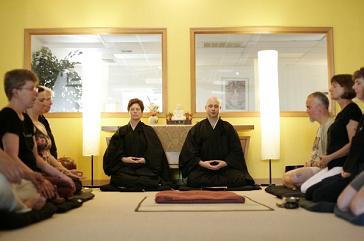 <<
In this Sunday, June 19, 2011 photo, Rev. Karen Do-on Weik and her
husband Rev. Jay Rinsen Weik meditate at the Toledo Zen Center in
Holland, Ohio. The two have created a Sunday school and other programs
to be especially welcoming to families. Many U.S. Buddhists say that
meditation centers aren’t especially welcoming of children, and some
worry it will cost them the next generation of adherents. (JD Pooley -
AP)
<<
In this Sunday, June 19, 2011 photo, Rev. Karen Do-on Weik and her
husband Rev. Jay Rinsen Weik meditate at the Toledo Zen Center in
Holland, Ohio. The two have created a Sunday school and other programs
to be especially welcoming to families. Many U.S. Buddhists say that
meditation centers aren’t especially welcoming of children, and some
worry it will cost them the next generation of adherents. (JD Pooley -
AP)
Why is a faith founded under a Bodhi tree in India 2,500 years ago enjoying a newfound popularity in America today?
There is no such thing as a historic North American Buddhist
tradition, a fact that is crucial to understanding and facilitating
Buddhism’s blossoming. This growth is all the more remarkable given that
Buddhism was arguably the most recent import of a major religion to
North America from the East. It’s important to note that Western
practitioners meditating in Massachusetts or applying the Eight-fold
Path in Portland often reach back to the established Buddhist traditions
of Sri Lanka or Thailand, Tibet, or Vietnam, Myanmar or Korea, China,
or Japan. But that’s not the only way to be Buddhist.
Some North American authors have suggested that North Americans might
consider foregoing any such wholesale adoptions of Eastern traditions in
deference to gradually developing their own. While not necessarily
endorsing this view, even the Tibetan teacher Shamar Rinpoche posited
that “Tibetans can benefit from being less sectarian, and certainly
non-Tibetans [in context principally Europeans and North Americans] have
no need for such distinctions.” The development of such a new North
American sacred tradition is more possible with Buddhism than most other
world religions owing to the relative simplicity and universal
applicability of the dharma’s core principles and the Buddha’s
teachings. That is partly because the dharma does not rely on faith in
any deific being as conditions to one’s beliefs, as do other religions.
Still, some wonder: Does a practitioner born and raised in North
America more easily adopt Buddhism if he takes it wholesale from the
East?
One way to look at this question is through the example of practice.
When done correctly, what Buddhist meditators refer to as
“sitting”–whether following the vipassana or zazen (or other) approaches
to sitting meditation–does not rely on ceremonial chanting and
recitations and actions that typically surround collective meditation
sessions. This is not to say such ceremonial activities normally
performed in an ancient or modern Eastern language are not useful or
helpful. This is only to say they are not a necessity for the gradual
expansion of consciousness that is the result of regular meditation. If
one accepts this basic premise, which can be supported by the sutras
attributed to the Buddha, then the conclusion that North Americans could
conceivably develop their own Buddhist tradition some day is perfectly
rational, if not probable.
After all, none of the cultural accessories of Buddhist practices in
the East came into being overnight; they themselves developed over time.
In Buddhism, that which does not differ from culture to culture or
era to era is the state of a meditator’s mind and presence when that
person is sitting in true mediation.
In association with other core teachings of the Buddha, such as
compassion, non-violence, and loving-kindness all found within the
Eight-fold Path, the attainment of the expanded states of consciousness
almost always occurs only through regular and constant and diligent
meditation practice, or sitting. This fact supersedes every associated
ceremonial activity, whether Eastern in origin or some new (as yet
unrealized) North American form. While such culture-based ceremony can
be useful and helpful as a docent to meditation, if it becomes the
practitioner’s focus, it becomes a distraction.
North American Buddhists are likely to create their own traditions
and schools of thought, but they should do so with the awareness that
they are forging a new Buddhist culture, not the ‘true’ Buddhist
culture.
If they don’t recognize this fact, the same problem of adaptation
would also apply, hypothetically, to any developed North American
Buddhist tradition 900 years in the future either by its devout
ecclesiastical adherents or when first introduced to the population of
some other culture that had never
been exposed to the teachings of the Buddha.
-----------
William Wilson Quinn is a scholar of Buddhism and brother of On Faith’s Sally Quinn.
Source: http://www.washingtonpost.com/blogs/guest-voices/post/whats-an-american-buddhist/2012/06/17/gJQAJCQrjV_blog.html